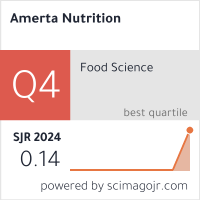Differences in the Nutritional and Micronutrient Malnutrition Status Among Primary School Children Aged 8–13 Years in Bogor, Indonesia
Perbedaan Status Gizi dan Malnutrisi Mikronutrien pada Anak Sekolah Dasar Usia 8–13 Tahun di Bogor, Indonesia
Background: Indonesia is experiencing a triple burden of malnutrition, defined as the coexistence of undernutrition, overnutrition, and micronutrient deficiencies. The majority of previous research has focused on the first 1000 days of life, while studies on school-age children remain limited, despite this developmental period being crucial for determining future health and well-being.
Objectives: The objective of this study is to analyze the prevalence of undernutrition, overnutrition, and micronutrient deficiencies among primary school children in Bogor, Indonesia.
Methods: This cross-sectional study included 915 fourth- and fifth-grade students who were selected for inclusion. The collected data encompassed individual characteristics, family socioeconomic status, anthropometric measurements (actual body weight, height, and skinfold thickness), and blood biomarkers. Nutritional status was assessed using BMI-for-age (BMI/A), body fat percentage (Slaughter equation), hemoglobin levels (non-cyanide method), and serum concentrations of vitamin A and B12 (Liquid Chromatography and Mass Spectrometry, LCMS).
Results: The prevalence of chronic energy deficiency was 2.4%, overnutrition (overweight and obesity) was 12.4%, and high body fat was 12.8%. Micronutrient deficiencies were prevalent, with 40.1% of subjects experiencing anemia, 18.6% exhibiting vitamin A deficiency, and 52.2% demonstrating vitamin B12 deficiency. No statistically significant differences were found in nutritional status between boys and girls, as measured by BMI/A and blood biomarkers. However, girls had significantly higher body fat percentages (p-value<0.001).
Conclusions: The prevalence of micronutrient deficiencies was found to exceed that of both undernutrition and overnutrition. Further research is needed to explore the underlying factors contributing to these nutritional issues, considering various covariates. Targeted and specific interventions are critical in order to prevent and address the triple burden of malnutrition among primary school children in Bogor, Indonesia.
Fund, U. N. C. The State of Children in Indonesia – Trends, Opportunities and Challenges for Realizing Children’s Rights. UNICEF East Asia and the Pacific Regional Office https://www.unicef.org/indonesia/sites/unicef.org.indonesia/files/2020-06/The-State-of-Children-in-Indonesia-2020.pdf (2020).
Chaparro, C., Oot, L. & Sethuraman, K. Overview of the nutrition situation in seven countries in Southeast Asia. Washington, DC FHI 360, (2014).
UNICEF. Southeast Asia regional report on maternal nutrition and complementary feeding. UNICEF East Asia Pacific Reg. Off. (2021).
Global Nutrition Report. 2020 Global Nutrition Report: Action on Equity to End Malnutrition. https://media.globalnutritionreport.org/documents/2020_Global_Nutrition_Report_2hrssKo.pdf (2020).
Haddad, L., Cameron, L. & Barnett, I. The double burden of malnutrition in SE Asia and the Pacific: priorities, policies and politics. Health Policy Plan. 30, 1193–1206 (2015). DOI: 10.1093/heapol/czu129.
Rachmi, C. N., Li, M. & Baur, L. A. The double burden of malnutrition in Association of South East Asian Nations (ASEAN) countries: a comprehensive review of the literature. Asia Pac. J. Clin. Nutr. 27, 736–755 (2018). DOI: 10.6133/apjcn.062018.02
Roos, N. et al. Micronutrient status of populations and preventive nutrition interventions in South East Asia. Matern. Child Health J. 23, 29–45 (2019). DOI:10.1007/s10995-018-2639-2.
Ritchie, H. Micronutrient deciency. Our world in data. (2022).
WHO. Micronutrient. (2022).
Von Grebmer, K. et al. Synopsis: 2014 Global Hunger Index: The Challenge of Hidden Hunger. vol. 83 (Intl Food Policy Res Inst, 2014).
Stevens, G. A. et al. National, regional, and global estimates of anaemia by severity in women and children for 2000–19: a pooled analysis of population-representative data. Lancet Glob. Heal. 10, e627–e639 (2022). DOI: 10.1016/S2214-109X(22)00084-5.
Zimmermann, M. B. & Hurrell, R. F. Nutritional iron deficiency. Lancet 370, 511–520 (2007). DOI: 10.1016/S0140-6736(07)61235-5.
Umasanker, S. et al. Vitamin B12 deficiency in children from Northern India: Time to reconsider nutritional handicaps. J. Fam. Med. Prim. Care 9, 4985–4991 (2020). DOI: 10.4103/jfmpc.jfmpc_712_20.
Darnton-Hill, I. Public health aspects in the prevention and control of vitamin deficiencies. Curr. Dev. Nutr. 3, nzz075 (2019). DOI: 10.1093/cdn/nzz075.
World Health Organization. Global Prevalence of Vitamin A Deficiency in Populations at Risk 1995–2005: WHO Global Database on Vitamin A Deficiency. https://iris.who.int/bitstream/handle/10665/44110/9789241598019_eng.pdf (2009).
Cañete, A., Cano, E., Muñoz-Chápuli, R. & Carmona, R. Role of vitamin A/retinoic acid in regulation of embryonic and adult hematopoiesis. Nutrients 9, 159 (2017). DOI: 10.3390/nu9020159.
Xu, Y. et al. Global patterns in vision loss burden due to vitamin A deficiency from 1990 to 2017. Public Health Nutr. 24, 5786–5794 (2021). DOI: 10.1017/S1368980021001324.
UNICEF. Tackling the ‘triple burden’ of malnutrition in Indonesia. https://www.unicef.org/indonesia/nutrition?gad_source= (2024).
Blankenship, J. L., Rudert, C. & Aguayo, V. M. Triple trouble: Understanding the burden of child undernutrition, micronutrient deficiencies, and overweight in East Asia and the Pacific. Matern. Child Nutr. 16, e12950 (2020). DOI: 10.1111/mcn.12950.
Kementerian Kesehatan RI. Hasil Survey Status Gizi Indonesia (SSGI) 2022. https://kesmas.kemkes.go.id/assets/uploads/contents/attachments/09fb5b8ccfdf088080f2521ff0b4374f.pdf (2022).
Kementerian Kesehatan RI. Riset Kesehatan Dasar 2018. https://kesmas.kemkes.go.id/assets/upload/dir_519d41d8cd98f00/files/Hasil-riskesdas-2018_1274.pdf (2018).
Saavedra, J. M. & Prentice, A. M. Nutrition in School-age Children: a Rationale for Revisiting Priorities. Nutr. Rev. 81, 823–843 (2023). DOI: 10.1093/nutrit/nuac089.
Kementerian Kesehatan RI. Peraturan Menteri Kesehatan Republik Indonesia No. 2 Tahun 2020 tentang Status Antropometri Anak. http://hukor.kemkes.go.id/uploads/produk_hukum/PMK_No__2_Th_2020_ttg_Standar_Antropometri_Anak.pdf (2020).
Slaughter, M. H. et al. Skinfold equations for estimation of body fatness in children and youth. Hum. Biol. 709–723 (1988).
Omron. Omron Instruction Manual. https://omronhealthcare.com/wp-content/uploads/1665708-0F_HBF-514C-Z_E_M_web_alt_text_acc.pdf (2024).
WHO. Anaemia. https://www.who.int/data/nutrition/nlis/info/anaemia (2011).
Wang, M. et al. Nutrition assessment of vitamin A and vitamin D in northeast Chinese population based-on SPE/UPLC/PDA. BMC Nutr. 4, 1–7 (2018). DOI: 10.1186/s40795-018-0219-x.
WebMD Editorial Contributors. What’s a Vitamin B12 Test? https://www.webmd.com/a-to-z-guides/vitamin-b12-test (2024).
Firmansyah, H., Purba, E. M., Purba, R. & Rosmiati, R. Household Food Insecurity and its Association with Nutritional Status of Under Five Children in Indonesia. Media Publ. Promosi Kesehat. Indones. 7, 2546–2552 (2024). DOI: 10.56338/mppki.v7i10.6197.
Singh, S. K. et al. Cultural and contextual drivers of triple burden of malnutrition among children in India. Nutrients 15, 3478 (2023). DOI: 10.3390/nu15153478.
Gebregergis, C. M. Socioeconomic determinants of child malnutrition: Evidence from Ethiopia. Discov. Glob. Soc. 2, 47 (2024). DOI: 10.1007/s44282-024-00062-8.
Shrestha, B. Mother’s education and antenatal care visits in Nepal. Tribhuvan Univ. J. 32, 153–164 (2018). DOI: 10.3126/tuj.v32i2.24712.
Etnis, A. R., Hutomo, W. M. P., Su, H. M., Rahman, I. & Kolong, E. Socioeconomic Factors and Its Correlation with Nutritional Status in Toddlers: A Study in Papua. J. Heal. Sci. Epidemiol. 2, 83–89 (2024). DOI: 10.62404/jhse.v2i2.49.
Batubara, J. R. Adolescent Development (Perkembangan Remaja). Sari Pediatr. 12, 21–29 (2010).
Schönbeck, Y., Van Dommelen, P., HiraSing, R. A. & Van Buuren, S. Thinness in the era of obesity: trends in children and adolescents in The Netherlands since 1980. Eur. J. Public Health 25, 268–273 (2015). DOI: 10.1093/eurpub/cku130.
Zong, Y. et al. Secular trends in overweight and obesity among urban children and adolescents, 2003–2012: a serial cross-sectional study in Guangzhou, China. Sci. Rep. 7, 12042 (2017). DOI: 10.1038/s41598-017-12094-z.
Taras, H. & Potts‐Datema, W. Obesity and student performance at school. J. Sch. Health 75, 291–295 (2005).
Booth, J. N. et al. Obesity impairs academic attainment in adolescence: findings from ALSPAC, a UK cohort. Int. J. Obes. 38, 1335–1342 (2014). DOI: 10.1111/j.1746-1561.2005.00040.x.
Cicek, B. et al. Four-site skinfolds and body fat percentage references in 6-to-17-year old Turkish children and adolescents. J Pak Med Assoc 64, 1154–1161 (2014).
Marrodán, M. D. et al. Development of subcutaneous fat in Spanish and Latin American children and adolescents: Reference values for biceps, triceps, subscapular and suprailiac skinfolds. Homo 68, 145–155 (2017). DOI: 10.1016/j.jchb.2017.02.003.
Wanghi, G. I., Lytle, L. & Buhendwa, A. R. Body Mass Index Correlates with Body Fat Percentage in Children and Adolescents in the Democratic Republic of the Congo: A cross sectional study. Afr. J. Health Sci. 34, 2–11 (2021).
Olivieri, F., Semproli, S., Pettener, D. & Toselli, S. Growth and malnutrition of rural Zimbabwean children (6–17 years of age). Am. J. Phys. Anthropol. Off. Publ. Am. Assoc. Phys. Anthropol. 136, 214–222 (2008). DOI: 10.1002/ajpa.20797.
Grundy, S. M., Williams, C. & Vega, G. L. Upper body fat predicts metabolic syndrome similarly in men and women. Eur. J. Clin. Invest. 48, e12941 (2018). DOI: 10.1111/eci.12941.
Jorgensen, J. M., Crespo‐Bellido, M. & Dewey, K. G. Variation in hemoglobin across the life cycle and between males and females. Ann. N. Y. Acad. Sci. 1450, 105–125 (2019). DOI: 10.1111/nyas.14096.
Hollowell, J. G. et al. Hematological and iron-related analytes--reference data for persons aged 1 year and over: United States, 1988-94. Vital Health Stat. 11. 1–156 (2005).
Adeli, K. et al. Complex biological profile of hematologic markers across pediatric, adult, and geriatric ages: establishment of robust pediatric and adult reference intervals on the basis of the Canadian Health Measures Survey. Clin. Chem. 61, 1075–1086 (2015). DOI: 10.1373/clinchem.2015.240531.
Åsberg, A. E., Mikkelsen, G., Aune, M. W. & Åsberg, A. Empty iron stores in children and young adults—the diagnostic accuracy of MCV, MCH, and MCHC. Int. J. Lab. Hematol. 36, 98–104 (2014). DOI: 10.1111/ijlh.12132.
Zeleke, M. B., Shaka, M. F., Anbesse, A. T. & Tesfaye, S. H. Anemia and Its Determinants among Male and Female Adolescents in Southern Ethiopia: A Comparative Cross-Sectional Study. Anemia 2020, 3906129 (2020).
Gardner, W. & Kassebaum, N. Global, regional, and national prevalence of anemia and its causes in 204 countries and territories, 1990–2019. Curr. Dev. Nutr. 4, nzaa053_035 (2020). DOI: 10.1093/cdn/nzaa053_035.
AbuKishk, N. et al. Anaemia prevalence in children newly registered at UNRWA schools: a cross-sectional study. BMJ Open 10, e034705 (2020). DOI: 10.1136/bmjopen-2019-034705.
Hassan, T. H. et al. Impact of iron deficiency anemia on the function of the immune system in children. Medicine (Baltimore). 95, e5395 (2016). DOI: 10.1097/MD.0000000000005395.
Hill, D. L. et al. Immune system development varies according to age, location, and anemia in African children. Sci. Transl. Med. 12, eaaw9522 (2020). DOI: 10.1126/scitranslmed.aaw9522.
Kassebaum, N. J. et al. A systematic analysis of global anemia burden from 1990 to 2010. Blood, J. Am. Soc. Hematol. 123, 615–624 (2014).
Wu, J. et al. Prevalence of anemia in Chinese children and adolescents and its associated factors. Int. J. Environ. Res. Public Health 16, 1416 (2019). DOI: 10.3390/ijerph16081416.
Yang, Z., Li, Y., Hu, P., Ma, J. & Song, Y. Prevalence of anemia and its associated factors among Chinese 9-, 12-, and 14-year-old children: results from 2014 Chinese national survey on students constitution and health. Int. J. Environ. Res. Public Health 17, 1474 (2020). DOI: 10.3390/ijerph17051474.
Zou, Y. et al. The rural-urban difference in BMI and anemia among children and adolescents. Int. J. Environ. Res. Public Health 13, 1020 (2016). DOI: 10.3390/ijerph13101020.
Birhanu, M., Gedefaw, L. & Asres, Y. Anemia among school-age children: magnitude, severity and associated factors in Pawe town, Benishangul-Gumuz region, Northwest Ethiopia. Ethiop. J. Health Sci. 28, 259–266 (2018). DOI: 10.4314/ejhs.v28i3.3.
Low, M., Farrell, A., Biggs, B.-A. & Pasricha, S.-R. Effects of daily iron supplementation in primary-school–aged children: systematic review and meta-analysis of randomized controlled trials. Cmaj 185, E791–E802 (2013). DOI: 10.1503/cmaj.130628.
Aibana, O. et al. Impact of vitamin A and carotenoids on the risk of tuberculosis progression. Clin. Infect. Dis. 65, 900–909 (2017). DOI: 10.1093/cid/cix476.
Liu, X. et al. Correlation between Nutrition and Symptoms: Nutritional Survey of Children with Autism Spectrum Disorder in Chongqing, China. Nutrients 8, 294 (2016). DOI: 10.3390/nu8050294.
Wołoszynowska-Fraser, M. U., Kouchmeshky, A. & McCaffery, P. Vitamin A and retinoic acid in cognition and cognitive disease. Annu. Rev. Nutr. 40, 247–272 (2020). DOI: 10.1146/annurev-nutr-122319-034227.
Carazo, A. et al. Vitamin A Update: Forms, Sources, Kinetics, Detection, Function, Deficiency, Therapeutic Use and Toxicity. Nutrients 13, 1703 (2021). DOI: 10.3390/nu13051703.
Green, R. et al. Vitamin B12 deficiency. Nat. Rev. Dis. Prim. 3, 1–20 (2017). DOI: 10.1038/nrdp.2017.40.
Popkin, B. M., Corvalan, C. & Grummer-Strawn, L. M. Dynamics of the double burden of malnutrition and the changing nutrition reality. Lancet 395, 65–74 (2020). DOI: 10.1016/S0140-6736(19)32497-3.
Cristancho, C., Mogensen, K. M. & Robinson, M. K. Malnutrition in patients with obesity: An overview perspective. Nutr. Clin. Pract. (2024) doi:10.1002/ncp.11228.
Sahiledengle, B. & Mwanri, L. Unveiling the crisis of the double burden of malnutrition. Lancet Glob. Heal. (2024) doi:10.1016/s2214-109x(24)00001-9.
Prentice, A. M. The Triple Burden of Malnutrition in the Era of Globalization. in Nestlé Nutrition Institute Workshop series (2023). doi:10.1159/000529005.
Song, L., Zhang, Y., Chen, T., Maitusong, P. & Lian, X. Association of body perception and dietary weight management behaviours among children and adolescents aged 6–17 years in China: cross-sectional study using CHNS (2015). BMC Public Health 22, 175 (2022). DOI: 10.1186/s12889-022-12574-6.
Dijkhuizen, M. A., Greffeille, V., Roos, N., Berger, J. & Wieringa, F. T. Interventions to improve micronutrient status of women of reproductive age in Southeast Asia: a narrative review on what works, what might work, and what doesn’t work. Matern. Child Health J. 23, 18–28 (2019). DOI: 10.1007/s10995-018-2637-4.
Plakida, O. L., Goroshkov, O. V, Vastyanov, R. S., Matyushenko, P. M. & Ostapchuk, K. V. International programs to provide school-age children with nutrition. Inter collegas (2023) doi:10.35339/ic.10.2.pgv.
Potapkina, E. et al. An Integrated Approach to the High-Quality, Safe and Healthy Nutrition Provision for Schoolchildren. Индустрия питания (2024) doi:10.29141/2500-1922-2024-9-1-10.
Nsubuga, S. N. The Role of Food Policy and Global Nutrition Programs in Combating Malnutrition. NEWPORT Int. J. PUBLIC Heal. Pharm. (2024) doi:10.59298/nijpp/2024/523962765.
Yazdanpanah, M. et al. Integrated food-based multi-actor approach to combat malnutrition. Front. Sustain. food Syst. (2023) doi:10.3389/fsufs.2023.1179768.
Copyright (c) 2025 Amerta Nutrition

This work is licensed under a Creative Commons Attribution-ShareAlike 4.0 International License.
AMERTA NUTR by Unair is licensed under a Creative Commons Attribution-ShareAlike 4.0 International License.
1. The journal allows the author to hold the copyright of the article without restrictions.
2. The journal allows the author(s) to retain publishing rights without restrictions
3. The legal formal aspect of journal publication accessibility refers to Creative Commons Attribution Share-Alike (CC BY-SA).
4. The Creative Commons Attribution Share-Alike (CC BY-SA) license allows re-distribution and re-use of a licensed work on the conditions that the creator is appropriately credited and that any derivative work is made available under "the same, similar or a compatible license”. Other than the conditions mentioned above, the editorial board is not responsible for copyright violation.












































